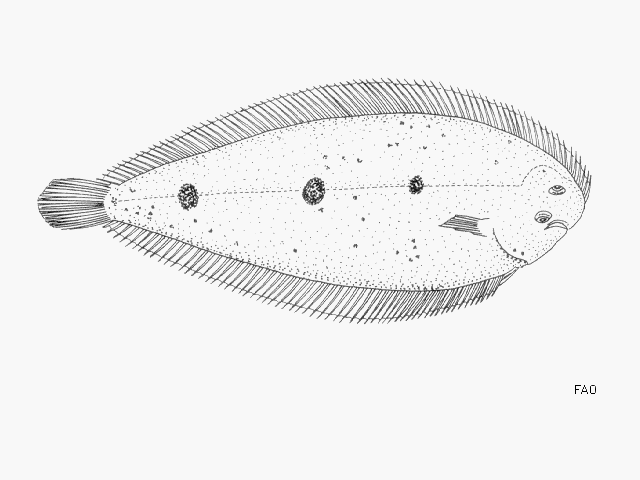| Soleidae (Soles) |
| 30 cm TL (male/unsexed) |
|
demersal; brackish; marine; depth range 10 - 30 m, |
| Eastern Central Atlantic: Mauritania to Gulf of Guinea (Ref. 5304, 57416); not in the south of Cape Lopez and not in the north of Rio de Oro (Ref. 5304). |
|
Dorsal spines (total): 0-0; Dorsal soft rays (total): 76-82; Anal spines: 0-0; Anal soft rays: 57-64. Diagnosis: flat and asymmetric body; eyes located on right side of head, except in reversed individuals; preopercle covered by skin and opercle entirely scaled; mouth small, more or less arched and inferior; dorsal and anal fins lacking spinous rays and separated from caudal fin; dorsal fin originating almost at anterior end of snout; pectoral fins present; lateral line straight, anteriorly prolonged into supratemporal line describing an arch above eyes; body covered with ctenoid scales (Ref. 57416).
Description: pectoral fin on blind side as well developed as that of eyed side; anterior nostril on blind side expanded into a rosette with extensively ciliate outer margin, posterior nostril close to anterior one (Ref. 57416).
Colouration: eyed side more or less dark brown, covered with more or less dark specks and with three blackish eyespots regularly spaced along lateral line; dorsal and anal fins of same colour as body; pectorals with black spot towards tips; blind side whitish (Ref. 57416). |
| Found on sand bottoms (Ref. 5304). Enters lagoons (Ref. 6805). Feeds on mollusks and other invertebrates (Ref. 5377). |
|
Data deficient (DD); Date assessed: 15 July 2014 Ref. (130435)
|
| harmless |
Source and more info: www.fishbase.org. For personal, classroom, and other internal use only. Not for publication.

